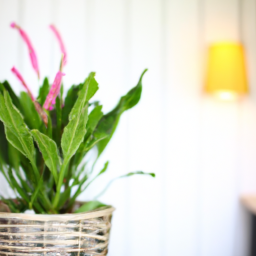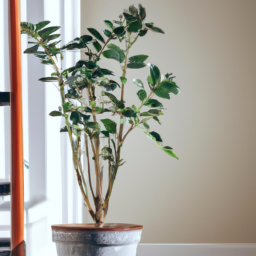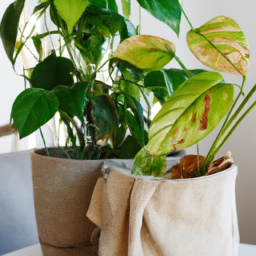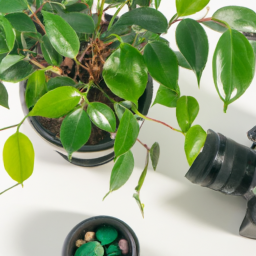
Have you ever considered bringing outdoor plants indoors during the colder months? If so, you’re not alone! Many plant enthusiasts are looking for ways to keep their greenery thriving all year round, even when the weather doesn’t cooperate. Whether you want to enjoy fresh herbs in the winter or simply want to add some greenery to your indoor space, bringing outdoor plants indoors can be a rewarding experience. In this blog post, we’ll explore some tips and tricks for successfully transitioning your plants from the great outdoors to the cozy confines of your home. So grab your gardening gloves and let’s get started!
Benefits of Bringing Outdoor Plants Indoors
Improved Air Quality
When you bring outdoor plants indoors, you are not only adding a touch of greenery to your space, but you are also improving the air quality. Plants are natural air purifiers and can help remove toxins from the air, such as formaldehyde and benzene. By having plants indoors, you can breathe easier and enjoy cleaner air in your home.
In addition to purifying the air, plants also release oxygen through the process of photosynthesis. This can help increase the oxygen levels in your home, making it a healthier environment for you and your family. So, by bringing outdoor plants indoors, you are not only beautifying your space, but you are also creating a healthier living environment.
Furthermore, plants can help regulate humidity levels in your home. They release water vapor through a process called transpiration, which can help increase the humidity in dry indoor spaces. This can be especially beneficial during the winter months when the air tends to be drier. Overall, bringing outdoor plants indoors can have a positive impact on the air quality and humidity levels in your home.
Reduced Stress and Improved Well-being
Incorporating outdoor plants into your indoor space can have a positive impact on your mental health and well-being. Studies have shown that being around plants can help reduce stress, anxiety, and depression. The presence of plants indoors can create a calming and relaxing environment, making your home a more peaceful place to be.
Taking care of plants can also be a therapeutic activity. The act of watering, pruning, and tending to your plants can help reduce stress and promote mindfulness. It can give you a sense of purpose and accomplishment, as you watch your plants grow and thrive under your care. So, by bringing outdoor plants indoors, you are not only enhancing the aesthetics of your space, but you are also improving your overall well-being.
Furthermore, having plants indoors can help boost your mood and increase productivity. Studies have shown that being around plants can help improve concentration, memory, and creativity. So, by incorporating outdoor plants into your indoor space, you can create a more positive and productive environment for yourself.
Enhanced Aesthetics and Ambiance
One of the most obvious benefits of bringing outdoor plants indoors is the enhanced aesthetics and ambiance they bring to your space. Plants can add a pop of color, texture, and life to any room, making it feel more vibrant and inviting. Whether you prefer lush foliage plants or colorful flowering plants, there are endless options to choose from to suit your personal style and decor.
In addition to adding visual interest, plants can also help soften hard surfaces and create a more welcoming atmosphere. They can help break up monotonous spaces and add a touch of nature to your indoor environment. By strategically placing plants around your home, you can create different focal points and enhance the overall design of your space.
Furthermore, plants can help create a sense of connection to the outdoors, even when you are inside. They can help bring a bit of nature into your home, making it feel more cozy and peaceful. So, by bringing outdoor plants indoors, you can transform your space into a green oasis that is both visually appealing and calming.

Tips for Successfully Transitioning Outdoor Plants Indoors
Bringing outdoor plants indoors can be a tricky process, but with the right care and preparation, you can ensure that your plants thrive in their new environment. In this guide, we will provide you with some expert tips on how to successfully transition your outdoor plants indoors.
Assessing Your Plants
Before bringing your outdoor plants indoors, it’s important to assess their health and condition. Look for any signs of pests or disease, as you don’t want to bring any unwanted guests into your home. Inspect the leaves, stems, and soil for any abnormalities, and treat any issues before making the transition.
Additionally, consider the specific needs of each plant. Some plants may require more sunlight, while others prefer shade. Make sure you have a good understanding of each plant’s requirements before bringing them indoors, so you can provide them with the proper care.
Finally, consider the size of your plants and whether they will fit comfortably in your indoor space. You may need to prune them or repot them into smaller containers to ensure they have enough room to grow.
Preparing Your Indoor Space
Before bringing your outdoor plants indoors, make sure you have a suitable space for them to thrive. Choose a location that receives adequate sunlight and has good air circulation. You may need to invest in grow lights or a humidifier to create the ideal environment for your plants.
Consider the temperature of your indoor space as well. Most outdoor plants prefer temperatures between 65-75 degrees Fahrenheit, so try to replicate these conditions as closely as possible. Avoid placing your plants near drafty windows or heating vents, as extreme temperature fluctuations can stress them out.
Finally, make sure you have the necessary supplies on hand, such as potting soil, fertilizer, and pruning shears. Having these items readily available will make it easier for you to care for your plants once they are indoors.
Caring for Your Plants Indoors
Once you have brought your outdoor plants indoors, it’s important to continue providing them with the proper care. Water your plants regularly, but be careful not to overwater them, as this can lead to root rot. Allow the soil to dry out slightly between waterings, and make sure your pots have good drainage.
Monitor your plants for any signs of stress, such as wilting leaves or yellowing foliage. If you notice any issues, adjust your care routine accordingly. You may need to move your plants to a different location or adjust their watering schedule to help them thrive.
Finally, be patient with your plants as they adjust to their new environment. It may take some time for them to acclimate to indoor conditions, so give them time to settle in before expecting to see new growth. With proper care and attention, your outdoor plants can thrive indoors and bring a touch of greenery to your home.

Best Practices for Caring for Outdoor Plants Inside
Preparing Your Plants for the Move
Before bringing your outdoor plants indoors, it’s important to prepare them for the transition. Start by inspecting your plants for any pests or diseases. It’s best to treat any issues before bringing them inside to prevent infestations in your home. You should also prune any dead or damaged branches to encourage new growth and ensure your plants are healthy.
Next, consider the lighting conditions in your home. Outdoor plants are accustomed to receiving direct sunlight, so you may need to place them near a window that gets plenty of natural light. If your home doesn’t receive much sunlight, you may need to invest in grow lights to help your plants thrive indoors.
Finally, make sure to repot your plants if necessary. Outdoor plants may have outgrown their current pots and will need more space to continue growing indoors. Choose a pot that is slightly larger than their current one and use well-draining soil to prevent root rot.
Creating the Right Environment
Once your outdoor plants are inside, it’s important to create the right environment for them to thrive. Maintain a consistent temperature in your home, as drastic temperature changes can stress your plants. Most outdoor plants prefer temperatures between 65-75 degrees Fahrenheit during the day and slightly cooler temperatures at night.
Humidity is another important factor to consider when caring for outdoor plants indoors. Most outdoor plants prefer higher humidity levels, so you may need to invest in a humidifier to create the ideal environment for your plants. You can also mist your plants regularly to increase humidity levels.
Watering is key to keeping your outdoor plants healthy indoors. Check the soil moisture regularly and water your plants when the top inch of soil is dry. Be careful not to overwater, as this can lead to root rot. It’s also a good idea to use a water-soluble fertilizer to provide your plants with the nutrients they need to thrive indoors.
Troubleshooting Common Issues
Even with the best care, outdoor plants can still face challenges when brought indoors. One common issue is pest infestations, which can be prevented by regularly inspecting your plants for pests and treating them promptly. You can use insecticidal soap or neem oil to control pests without harming your plants.
Another common issue is yellowing leaves, which can be a sign of overwatering, underwatering, or nutrient deficiencies. Adjust your watering schedule and fertilize your plants as needed to address these issues. You can also trim any yellowing leaves to encourage new growth.
If your plants are not thriving indoors, it may be helpful to repot them in fresh soil or move them to a different location in your home. Experiment with different lighting conditions and humidity levels to find the right environment for your plants to thrive.
Key Takeaways
As the weather gets colder and the days get shorter, it’s time to start thinking about bringing your outdoor plants indoors to protect them from the harsh conditions of winter. Whether you have a lush garden or just a few potted plants on your patio, transitioning them to an indoor environment can help them thrive during the colder months.
Before bringing your plants inside, it’s important to check for pests and diseases that could spread to your other houseplants. Give them a good rinse with water to remove any lingering insects or debris, and consider repotting them in fresh soil to give them a fresh start. Once inside, make sure they’re placed in a spot that receives plenty of sunlight and maintain a consistent watering schedule to keep them healthy and happy throughout the winter. By bringing your outdoor plants indoors, you can enjoy their beauty year-round and ensure they survive until spring arrives.
Top FAQs:
Q1: Can I bring my outdoor plants indoors during the winter?
A1: Yes, you can bring your outdoor plants indoors during the winter to protect them from the cold temperatures. Just make sure to acclimate them slowly to the indoor environment to prevent shock.
Q2: How do I prepare my outdoor plants for the transition indoors?
A2: Before bringing your outdoor plants indoors, make sure to inspect them for pests and diseases. Prune any dead or damaged leaves, and repot them if necessary. Also, consider providing them with a humidifier to mimic their outdoor environment.
Q3: What are some common mistakes to avoid when bringing outdoor plants indoors?
A3: Some common mistakes to avoid when bringing outdoor plants indoors include overwatering, placing them in direct sunlight, and not providing enough humidity. Make sure to research the specific needs of your plants before making the transition.
Q4: How often should I water my outdoor plants once they are indoors?
A4: The watering needs of your outdoor plants will likely change once they are indoors. Make sure to check the soil moisture regularly and water only when the top inch of the soil is dry. Avoid overwatering, as this can lead to root rot.
Q5: Can I bring all types of outdoor plants indoors?
A5: While many outdoor plants can be successfully brought indoors, some may not thrive in an indoor environment. Research the specific needs of each plant before making the transition, and be prepared to provide the necessary care to help them adapt.
Dr. Olivia Green is a botanist with over two decades of experience in indoor plant cultivation. She holds a Ph.D. in Plant Biology and has dedicated her career to researching plant behavior in controlled environments. Dr. Green is passionate about helping plant enthusiasts master the art of indoor gardening through her extensive knowledge and practical insights.


